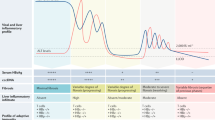Abstract
Hepatitis B virus (HBV) currently infects an estimated population of 2 billion individuals in the world, including 400 million people with chronic HBV infection. HBV virology, replication and the host’s immune response to HBV infection contribute to different infection outcomes. Acute hepatitis HBV infection is self-limiting but it leaves a residual infection that can become active in an individual during immunosuppression. In chronic HBV infection, the virus persistently replicates in hepatocytes leading to immune mediated hepatocellular damage. Despite the inability to remove the virus in more than 70 % of patients, current treatments for chronic HBV infection, interferon alpha and antiviral nucleotide/nucleoside analogues, aim to reduce viral replication to prevent or at least delay the progression to cirrhosis and hepatocellular carcinoma. In both self resolved acute and persistent HBV infection, the long term existence of chromatinised covalently closed circular DNA (cccDNA) in the nuclei of infected hepatocytes cannot be targeted by current treatments to eliminate these templates to eradicate the viral persistence. Identifying the mechanisms involve in the removal of infected hepatocytes will be useful as treatment options. In this context, DNA based novel therapeutic and immunization strategies might help to remove stable cccDNA and thus viral persistence.


Similar content being viewed by others
References
McMahon BJ. Epidemiology and natural history of hepatitis B. Semin Liver Dis. 2005;25(S1):3–8.
Lin CL, Kao JH. Hepatitis B viral factors and clinical outcomes of chronic hepatitis B. J Biomed Sci. 2008;15(2):137–45.
Ocama P, Opio CK, Lee WM. Hepatitis B virus infection: current status. Am J Med. 2005;118(12):1413.
Mast EE, Margolis HS, Fiore AE, Brink EW, Goldstein ST, Wang SA, Moyer LA, Bell BP, Alter MJ. A comprehensive immunization strategy to eliminate transmission of hepatitis B virus infection in the United States: recommendations of the Advisory Committee on Immunization Practices (ACIP) part 1: immunization of infants, children, and adolescents. MMWR Recomm Rep. 2005;54(RR-16):1–31.
Osiowy C, Gordon D, Borlang J, Giles E, Villeneuve JP. Hepatitis B virus genotype G epidemiology and co-infection with genotype A in Canada. J Gen Virol. 2008;89(12):3009–15.
Blumberg BS, Alter HJ, Visnich S. A new antigen in leukemia sera. JAMA. 1965;191:541–6.
Blumberg BS. Australia antigen and the biology of hepatitis B. Science. 1977;197(4298):17–25.
Brunello F, Emanuelli G, Camussi G. Markers of type B viral hepatitis. Minerva Med. 1979;70(41):2791–800.
Alberti A, Diana S, Scullard GH, Eddleston WF, Williams R. Full and empty Dane particles in chronic hepatitis B virus infection: relation to hepatitis B e antigen and presence of liver damage. Gastroenterology. 1978;75(5):869–74.
He BG, Melnick JL, Siddiqui A, Robinson WS, Law SW, Lai EC. Molecular cloning and characterization of the cDNA coding for hepatitis B virus surface antigen. Sci Sin [B]. 1985;28(1):49–59.
Dejean A, Brechot C, Tiollais P, Wain-Hobson S. Characterization of integrated hepatitis B viral DNA cloned from a human hepatoma and the hepatoma-derived cell line PLC/PRF/5. Proc Natl Acad Sci. 1983;80(9):2505–9.
Kobayashi M, Koike K. Complete nucleotide sequence of hepatitis B virus DNA of subtype adr and its conserved gene organization. Gene. 1984;30(1–3):227–32.
Kramvis A, Kew M, François G. Hepatitis B virus genotypes. Vaccine. 2005;23(19):2409–23.
Norder H, Couroucé AM, Coursaget P, Echevarria JM, Lee SD, Mushahwar IK, Robertson BH, Locarnini S, Magnius LO. Genetic diversity of hepatitis B virus strains derived worldwide: genotypes, subgenotypes, and HBsAg subtypes. Intervirology. 2004;47(6):289–309.
Neurath AR, Kent SB, Strick N, Parker K. Identification and chemical synthesis of a host cell receptor binding site on hepatitis B virus. Cell. 1986;46(3):429–36.
Glebe D, Urban S. Viral and cellular determinants involved in hepadnaviral entry. World J Gastroenterol. 2007;13(1):22–38.
Jilbert AR, Mason WS, Kann M. Hepatitis B Virus Replication. In: Locarnini S, Lai C-L, editors. Hepatitis B Virus. London, Atlanta: International Medical Press; 2008. p. 4.1–4.13.
Kim DH, Ni Y, Lee SH, Urban S, Han KH. An anti-viral peptide derived from the pre-S1 surface protein of hepatitis B virus. BMB Rep. 2008;41(9):640–4.
Zoulim F. Combination of nucleoside analogues in the treatment of chronic hepatitis B virus infection: lesson from experimental models. J Antimicrob Chemother. 2005;55(5):608–11.
Bartenschlager R, Schaller H. Hepadnaviral assembly is initiated by polymerase binding to the encapsidation signal in the viral RNA genome. EMBO J. 2008;11(9):3413–20.
Newbold JE, Xin H, Tencza M, Sherman G, Dean J, Bowden S, Locarnini S. The covalently closed duplex form of the hepadnavirus genome exists in situ as a heterogeneous population of viral minichromosomes. J Virol. 1995;69(6):3350–7.
Block TM, Guo H, Guo JT. Molecular virology of hepatitis B virus for clinicians. Clin Liver Dis. 2007;11(4):685–706.
Bruss V. Hepatitis B virus morphogenesis. World J Gastroenterol. 2007;13(1):65–73.
Mhamdi M, Funk A, Hohenberg H, Will H, Sirma H. Assembly and budding of a hepatitis B virus is mediated by a novel type of intracellular vesicles. Hepatology. 2007;46(1):95–106.
Funk A, Mhamdi M, Hohenberg H, Heeren J, Reimer R, Lambert C, Prange R, Sirma H. Duck hepatitis B virus requires cholesterol for endosomal escape during virus entry. J Virol. 2008;82(21):10532–42.
Sprengers D, Janssen HL. Immunomodulatory therapy for chronic hepatitis B virus infection in children. Fundam Clin Pharmacol. 2005;19(4):447.
Lok AS, McMahon BJ. Chronic hepatitis B. Hepatology. 2001;34(6):1225–41.
Kara IH, Yilmaz ME, Suner A, Kadiroglu AK, Isikoglu B. The evaluation of immune responses that occur after HBV infection and HBV vaccination in hemodialysis patients. Vaccine. 2004;22(29–30):3963–7.
Akbar SM, Abe M, Masumoto T, Horiike N, Onji M. Mechanism of action of vaccine therapy in murine hepatitis B virus carriers: vaccine-induced activation of antigen presenting dendritic cells. J Hepatol. 1999;30(5):755–64.
Guidotti LG, Rochford R, Chung J, Shapiro M, Purcell R, Chisari FV. Viral clearance without destruction of infected cells during acute HBV infection. Science. 1999;284(5415):825–9.
Weber F, Kochs G, Haller O. Inverse interference: how viruses fight the interferon system. Viral Immunol. 2004;17(4):498–515.
Scully LJ, Brown D, Lloyd C, Shein R, Thomas HC. Immunological studies before and during interferon therapy in chronic HBV infection: identification of factors predicting response. Hepatology. 1990;12(5):1111–7.
Dandri M, Petersen J. Hepatitis B virus cccDNA clearance: killing for curing? Hepatology. 2005;42(6):1453–5.
Rosenthal KL. “Tweaking innate immunity: the promise of innate immunologicals as anti-infectives. Can J Infect Dis Med Microbiol. 2006;17(5):307–14.
Visvanathan K, Skinner NA, Thompson AJ, Riordan SM, Sozzi V, Edwards R, Rodgers S, Kurtovic J, Chang J, Lewin S, Desmond P, Locarnini S. Regulation of Toll-like receptor-2 expression in chronic hepatitis B by the precore protein. Hepatology. 2007;45(1):102–10.
Valsamakis A. Molecular testing in the diagnosis and management of chronic hepatitis B. Clin Microbiol Rev. 2007;20(3):426–39.
Rehermann B. Intrahepatic T cells in hepatitis B: viral control versus liver cell injury. J Exp Med. 2000;191(8):1263–8.
Fattovich G, Bortolotti F, Donato F. Natural history of chronic hepatitis B: special emphasis on disease progression and prognostic factors. J Hepatol. 2008;48(2):335–52.
Yuen MF, Lai CL. In: Locarnini S, Lai CL, editors. The natural history of chronic hepatitis B, vol. 1. London, Atlanta: International Medical Press; 2008. p. 12.1–12.11.
Villeneuve JP. The natural history of chronic hepatitis B virus infection. J Clin Virol. 2005;34(1):S139–42.
Dai CY, Chuang WL, Huang JF, Yu ML. Hepatitis B e antigen-negative patients with persistently normal alanine aminotransferase levels and hepatitis B virus DNA >2000 IU/mL. Hepatology. 2009;49(2):705–6.
Fabrizi F, Martin P, Dixit V, Bunnapradist S, Dulai G. Meta-analysis: the effect of age on immunological response to hepatitis B vaccine in end-stage renal disease. Aliment Pharmacol Ther. 2004;20(10):1053–62.
Mancini-Bourgine M, Fontaine H, Scott-Algara D, Pol S, Brechot C, Michel ML. Induction or expansion of T-cell responses by a hepatitis B DNA vaccine administered to chronic HBV carriers. Hepatology. 2004;40(4):874–82.
Harley EJ, Kellner A. A controlled clinical trial of the efficacy of the hepatitis B vaccine (Heptavax B). Hepatology. 1981;1(5):377–85.
Zuckerman J. Immune response to a new hepatitis B vaccine in healthcare workers who had not responded to standard vaccine: randomised double blind dose-response study. BMJ. 1997;314(7077):329–33.
McMahon BJ. Antibody levels and protection after hepatitis B vaccine: results of a 22- year follow-up study and response to a booster dose. J Infect Dis. 2009;200:1390–6.
Chathuranga LS, Noordeen F, Abeykoon AM. Immune response to hepatitis B vaccine in a group of health care workers in Sri Lanka. Int J Infect Dis. 2013;17(11):e1078–9.
Leuridan E, Van Damme P. Hepatitis B and the need for a booster dose. CID. 2011;53:68–75.
Hadziyannis SJ, Papatheodoridis GV, Vassilopoulos D. Treatment of HBeAg-negative chronic hepatitis B. Semin Liver Dis. 2003;23(1):81–8.
Younger HM, Bathgate AJ, Hayes PC. Review article: nucleoside analogues for the treatment of chronic hepatitis B. Aliment Pharmacol Ther. 2004;20(11–12):1211–30.
Fournier C, Zoulim F. Combination therapy in chronic hepatitis B. Gastroenterol Clin Biol. 2008;32(1 Pt 2):S42–9.
Marcellin P, Asselah T, Boyer N. Treatment of chronic hepatitis B. J Viral Hepat. 2005;12(4):333–45.
Rapti I, Dimou E, Mitsoula P, Hadziyannis SJ. Adding-on versus switching-to adefovir therapy in lamivudine-resistant HBeAg-negative chronic hepatitis B. Hepatology. 2007;45(2):307–13.
Moucari R, Mackiewicz V, Lada O, Ripault MP, Castelnau C, Martinot-Peignoux M, Dauvergne A, Asselah T, Boyer N, Bedossa P, Valla D, Vidaud M, Nicolas-Chanoine MH, Marcellin P. Early serum HBsAg drop: a strong predictor of sustained virological response to pegylated interferon alfa-2a in HBeAg-negative patients. Hepatology. 2009;49(4):1151–7.
Locarnini S, Bathholomeusz A. Emergence and patterns of drug resistance, vol. 1. London, Atlanta: International Medical Press; 2008. p. 12.1–12.11.
Liaw YF. Therapy of chronic hepatitis B: current challenges and opportunities. J Viral Hepat. 2002;9(6):393–9.
Zoulim F. Antiviral therapy of chronic hepatitis B: can we clear the virus and prevent drug resistance? Antivir Chem Chemother. 2004;15(6):299–305.
Noordeen F, Vaillant A, Jilbert AR. Nucleic acid polymers inhibit duck hepatitis B virus infection in vitro. Antimicrob Agents Chemother. 2013;57(11):5291–8.
Noordeen F, Vaillant A, Jilbert AR. Nucleic acid polymers prevent the establishment of duck hepatitis B virus infection in vivo. Antimicrob Agents Chemother. 2013;57(11):5299–306.
Al-Mahtab M, Bazinet M, Vaillant A. Preliminary evidence of rapid HBsAg seroconversion in patients with chronic hepatitis B (CHB) treated with a DNA-based amphipathic polymer. Antivir Res. 2010;86(1):A28.
Al-Mahtab M, Bazinet M, Vaillant A. REP 9AC is a potent HBsAg release inhibitor which clears serum HBSAg and elicits SVR in patients with chronic hepatitis B. J Hepatol. 2011;54(1):S34.
Noordeen F. Development of antiviral therapies for chronic hepatitis B virus infection. Digital research theses collection of University of Adelaide, 09PH N818. 2010. http://library.adelaide.edu.au/item/1523542.
Author information
Authors and Affiliations
Corresponding author
Rights and permissions
About this article
Cite this article
Noordeen, F. Hepatitis B virus infection: An insight into infection outcomes and recent treatment options. VirusDis. 26, 1–8 (2015). https://doi.org/10.1007/s13337-015-0247-y
Received:
Accepted:
Published:
Issue Date:
DOI: https://doi.org/10.1007/s13337-015-0247-y




